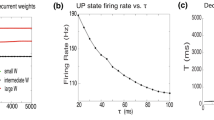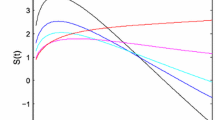Abstract.
The binding neuron model [A.K. Vidybida,BioSystems 48, 263 (1998)] is inspired by numerical simulation of Hodgkin-Huxley-type point neuron [A.K. Vidybida,Biol. Cybern. 74, 539 (1996)], as well as by the leaky integrate-and-fire (LIF) model [J.P. Segundo, D. Perkel, H. Wyman, H. Hegstad, G.P. Moore,Kybernetic 4, 157 (1968)]. In the binding neuron, the trace of an input is remembered for a fixed period of time after which it disappears completely. This is in the contrast with the above two models, where the postsynaptic potentials decay exponentially and can be forgotten only after triggering. The finiteness of memory in the binding neuron allows one to construct fast recurrent networks for computer modeling [A.K. Vidybida,BioSystems 71, 205 (2003)]. Recently, [A.K. Vidybida,BioSystems 89, 160 (2007)], the finiteness is utilized for exact mathematical description of the output stochastic process if the binding neuron is driven with the Poisson input stream. In this paper, it is expected that every output spike of single neuron is immediately fed back into its input. For this construction, externally fed with Poisson stream, the output stream is characterized in terms of interspike interval (ISI) probability density distribution if the neuron has threshold 2. For higher thresholds, the distribution is calculated numerically. The distributions are compared with those found for binding neuron without feedback, and for leaky integrator. It is concluded that the feedback presence can radically alter spiking statistics.
Similar content being viewed by others
References
A.K. Vidybida,BioSystems 48, 263 (1998)
A.K. Vidybida,Biol. Cybern. 74, 539 (1996)
J.P. Segundo, D. Perkel, H. Wyman, H. Hegstad, G.P. Moore, Kybernetic 4, 157 (1968)
A.K. Vidybida,BioSystems 71, 205 (2003)
A.K. Vidybida,BioSystems 89, 160 (2007)
R. Schmidt, Fundamentals of Neurophysiology (Springer, Berlin, 1975)
P. König, A.K. Engel, W. Singer,TINS 19, 130 (1996)
M. Rudolph, A. Destexhe, J. Comput. Neurosci. 14, 239 (2003)
J.J. Eggermont,Hearing Res. 56, 153 (1991)
P. König, N. Krüger, Biol. Cybern. 94, 325 (2006)
V. Aroniadou-Anderjaska, M. Ennis, M.T. Shipley,J. Neurophysiol. 82, 489 (1999)
R.A. Nicoll, C.E. Jahr,Nature 296, 441 (1982)
A.Y. Khinchin,V.A. Steklov Inst. Math. Trudy 49, 1 (1955)
A.L. Hodgkin, A.F. Huxley,J. Physiol. 125, 221 (1952)
N.S. Goel, N. Rychter-Dyn, J.R. Clay,J. theor. Biol. 34, 155 (1972)
T. Britvina, J.J. Eggermont,Biol. Cybern. 96, 245 (2006)
H. Haken, Advanced Synergetics (Springer, Berlin, 1983)
W. Feller,An introduction to probability theory and its applications(John Wiley & Sons, NY, 1966), Vol. 2
H. Haken, Eur. Phys. J. B 18, 545 (2000)
G.D. Smith,in Computational Cell Biology, edited by C.P. Fall, E.S. Marland, J.M. Wagnerand, J.J. Tyson (Springer, Singapore, 2002), pp. 285–319
M. Matsumoto, T. Nishimura,ACM Trans. Model. Comput. Simul. 8, 3 (1998)
A.N. Burkitt,Biol. Cybern. 95, 1 (2006)
A.V. Holden,Models of the stochastic activity of neurons (Lecture Notes in Biomathematics 12, Springer, Berlin, 1976)
L.M. Ricciardi,Diffusion Processes and Related Topics in Biology (Lecture Notes in Biomathematics 14, Springer, Berlin, 1977)
H.C. Tuckwell,Introduction to theoretical neurobiology (Cambridge University Press, Cambridge, 1988)
H.C. Tuckwell,Stochastic processes in the neurosciences (Society for Industrial and Applied Mathematics, Philadelphia, 1989)
A. Kolmogoroff, Mathematische Annalen 104, 415 (1931)
R. Miles,J. Physiol. 428, 61 (1990)
B. Barbour,Neuron 11, 759 (1993)
P. Andersen, in Fidia Research Foundation Neuroscience Award Lectures(Raven Press, Ltd, New York, 1991), pp. 51–71
P. Andersen, M. Raastad, J.F. Storm,in Cold Spring Harbor Symposia on Quantitative Biology (Cold Spring Harbor Laboratory Press, Cold Spring Harbor, 1990), pp. 81–86
A.K. Vidybida,Ukr. Math. J. 59, 1619 (2007)
W.R. Softky, C. Koch,J. Neurosci. 13, 334 (1993)
D.M. MacKay, in Self-Organizing Systems, edited by M.C. Yovitts, G.T. Jacobi, G.D. Goldstein (Spartan Books, Washington, 1962), pp. 37–48
Author information
Authors and Affiliations
Corresponding author
Additional information
An erratum to this article can be found at http://dx.doi.org/10.1140/epjb/e2009-00139-x
Rights and permissions
About this article
Cite this article
Vidybida, A. Output stream of binding neuron with instantaneous feedback. Eur. Phys. J. B 65, 577 (2008). https://doi.org/10.1140/epjb/e2008-00360-1
Received:
Revised:
Published:
DOI: https://doi.org/10.1140/epjb/e2008-00360-1




